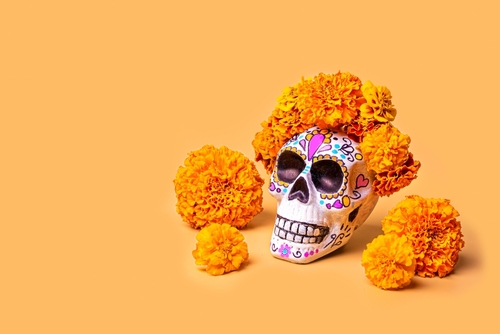Canada’s multicultural mosaic means traditions from around the world are shared and celebrated. Among them is Día de los Muertos, or Day of the Dead, a Mexican holiday that has found a place in Canadian cities with vibrant Mexican and Latin American communities. Every year in early November, you’ll find Day of the Dead celebrations honouring this unique tradition.
Although Día de los Muertos takes place around the same time as Halloween, the two are very different. Day of the Dead centres on remembering loved ones no longer with us, blending Indigenous roots with Catholic influences, and celebrating life through food, music, and colourful altars.
In this Remitly article, we’ll cover everything you need to know about Day of the Dead, from the significance of the day to important symbols, and where you can experience it in Canada. Whether you have Mexican heritage, are a newcomer in Canada looking for a unique event, or simply want to learn more, all are welcome.
What is Day of the Dead?
Day of the Dead, or Día de los Muertos, is a Mexican tradition with roots that stretch back thousands of years. It blends Indigenous beliefs about honouring ancestors with Catholic observances of All Saints’ Day and All Souls’ Day. Far from being morbid, Día de los Muertos is a vibrant and joyful occasion that celebrates life and memory.
Don’t let the name fool you; the focus of the holiday isn’t on death. Families come together to share food, music, and stories. It’s a way to turn grief into joy and is a connection that spans generations.
The celebration takes place on November 1 and 2. November 1, sometimes referred to as Día de los Angelitos (Day of the Little Angels), is dedicated to children, while November 2 is for adults. These dates reflect a deep-rooted belief that the boundary between the living and the dead temporarily dissolves and the departed return to visit the living.
Families often create ofrendas (altars), decorated with meaningful objects. The aim is to fill the space with their family members’ most-loved items and welcome them back.
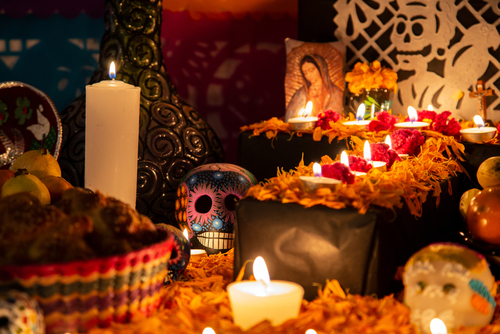
Day of the Dead traditions and symbols
Symbolism is a key component of Day of the Dead celebrations. Each item is meant to welcome the spirits of loved ones and honour their memory with joy.
- Altars (ofrendas): Families build altars at home or in cemeteries as a focal point for offerings. They often include food, drink, candles, and photos, creating a welcoming space for spirits to return.
- Marigold flowers (cempasúchil): It’s believed that marigolds can guide spirits home with their bright colour and strong scent. Many families scatter petals from the cemetery to the altar to show the way.
- Sugar skulls (calaveras): Representing life’s sweetness, these colourful skulls, often made from sugar or chocolate, are used to remove some of the stigma associated with death. The playful skulls typically have the loved one’s name written across the forehead.
- Bread (pan de muerto): This special bread, shared during gatherings, is flavoured with orange blossom and decorated with bone-shaped patterns and a small round piece on top to symbolize the cycle of life and death.
Beyond these symbols, music, dancing, and storytelling also keep memories alive. Traditional dances, songs, and live performances—sometimes including mariachi music—bring people together and keep memories alive.
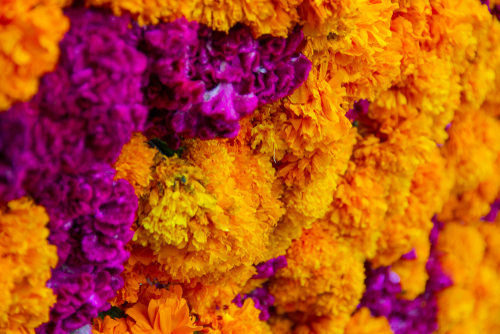
Day of the Dead events in Canada
Several cities in Canada host Day of the Dead celebrations, most notably in Toronto, Ottawa, Montreal, and Vancouver.
Toronto Day of the Dead events
- The main festival is put on by the Toronto Día de los Muertos Collective. It runs from around October 26 to November 3 at Wychwood Barns, a community cultural hub in the city.
- The Casa Maíz Cultural Centre and Grupo Teatro Libre put on dance and theatre shows.
- The Royal Ontario Museum runs a Day of the Dead exhibit annually. For more than 25 years, they’ve encouraged visitors to dive into the connection between life and death through art.
Ottawa Day of the Dead events
- Ottawa’s extensive Day of the Dead Festival typically runs from October 31 to November 2 at Byward Market. There’s a “Rattle Your Bones” dance party, art exhibitions, and an ofrenda contest where people compete for prizes.
Montreal Day of the Dead events
- Time Out Market at the Montreal Eaton Centre holds an annual event full of fun activities like the Day of the Dead Tunnel, Mariachi music, and face painting.
- PAAL Partageons le Monde hosts Day of the Dead celebrations all over the city. Activities include creating your own Day of the Dead skull and discovering the importance of the holiday’s sacred traditions.
Vancouver Day of the Dead events
- Various galleries and museums in Vancouver tailor exhibits to the Day of the Dead. They change annually, but in the past, the Polygon Gallery and the Museum of Anthropology at UBC have participated. Check out social media for upcoming events.
- As part of the greater celebrations for Latin American Heritage Month (LAHM), Vancouver hosts a Latin market at Granville Island. There are also ticketed events put on by the Nahualli Folklore Society with traditional music, dance, and colourful visuals.
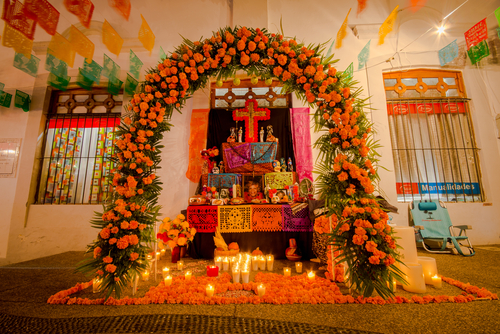
How to create your own Day of the Dead celebration
Setting up an ofrenda at home
If you want to take part in this Mexican tradition in Canada, you could create your own altar at home dedicated to loved ones:
- Choose your location: A small table, mantel, or shelf works well.
- Cover the surface: Using something colourful and bright, cover your surface. Orange is especially symbolic because of marigolds, but any vibrant colour will work.
- Add photos: Pick photos that evoke fond memories and place them at the centre of the altar.
- Include candles: These light the spirit’s way back. Incense is also a popular addition for purification.
- Add marigolds: Scatter fresh or paper marigolds on the altar or leading up to it.
- Decorate with skulls: Traditional sugar skulls are colourful and playful reminders of the cycle of life. If you enjoy baking, decorated homemade skull cookies are a nice addition.
- Place your offerings: Anything that made your loved one smile is ideal here, from toys and candy to pan de muerto and other favourite foods.
Some of these items may not be readily available in all parts of Canada, but many local Mexican or Latin grocery stores will often stock Day of the Dead-specific items from mid-October. Bakeries may offer pan de muerto and sugar skulls. Your local florist may have fresh marigolds available or offer the option to order. Otherwise, paper or plastic flowers found online or at craft stores will do the trick.
Safety note: If you have children at home, LED candles are a safer choice. If you use real candles or incense, place them in sturdy holders away from any paper decorations, keep the area ventilated, and never leave them unattended.
Traditional foods you can make
Food is such an important component of the Day of the Dead in Canada. Why not try making some traditional dishes at home?
Pan de muerto
A traditional recipe for two loaves includes:
- 4 cups all-purpose flour
- ½ cup granulated sugar (plus extra for dusting)
- 2 ¼ tsp active dry yeast (1 packet)
- ½ cup warm milk
- ½ cup unsalted butter, softened
- 3 large eggs
- ½ tsp salt
- 1 tablespoon orange zest
- 1 teaspoon orange blossom water
- 2 tbsp butter (melted, for brushing after baking).
Activate the yeast by mixing it with 1 tbsp of sugar in the warm milk. Let it sit for 5–10 minutes, until foamy.
In a large bowl, combine flour, the remaining sugar, salt, orange zest, and orange blossom water. Add the yeast mixture, eggs, and softened butter. Mix until the dough comes together.
Transfer the dough to a floured surface and knead for 10-12 minutes until smooth and elastic but still slightly tacky. Place dough in a greased bowl, cover with a towel, and let rise in a warm place for one and a half to two hours, or until it’s doubled in size.
Divide the dough into two portions. Shape each into a round loaf. From a small piece of dough, roll thin “bones” (to represent the deceased) and place them crisscrossed on top of each loaf, with a small ball (to represent the skull or heart) in the centre.
Place loaves on a baking sheet lined with parchment paper, cover loosely, and let rise for one hour. Bake at 350°F for 30 to 35 minutes. While the loaves are still warm, brush the tops with melted butter and sprinkle with sugar.
Tip: Orange blossom water can be purchased online, at specialty stores, or in some larger grocery stores. If you can’t find it, you can substitute one teaspoon of orange extract.
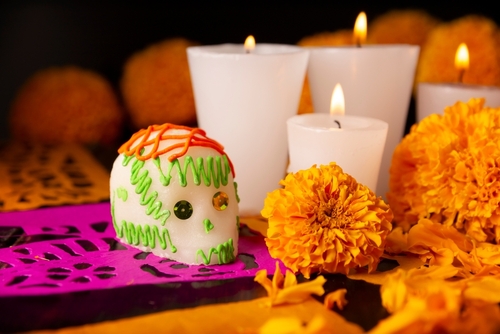
Sugar skulls
To make six medium-sized calaveras de azúcar, you’ll need:
- 2 cups granulated sugar
- 2 tsp meringue powder
- 2 tsp water
Combine the sugar and meringue powder, then add water until the mixture resembles damp sand. Press it into the skull moulds and let it dry for 12 to 24 hours.
To decorate, make royal icing by mixing 1 cup icing sugar with 1 tsp meringue powder and 1–2 tsp water until thick but pipeable. Then, separate into bowls and add food colouring. Use piping bags or small plastic bags to decorate the skulls with colourful designs.
Meringue powder is available in most larger Canadian grocery stores, and plastic skull moulds can be purchased online. If you need other ingredients or prefer to purchase pre-made Day of the Dead food items, here are some retailers to try:
- Toronto: Tienda Movil and Tierra Azteca
- Montreal: Sabor Latino and Supermarché Latino Mundial
- Vancouver: El Paisano and Fresh Is Best on Broadway
Day of the Dead activities for families and children
Although Day of the Dead celebrations include themes of death, that’s not the focus. The holiday is about celebrating life and remembering loved ones. With that in mind, activities can be appropriate for children of all ages.
Explain the tradition to kids as a joyful time to remember and honour loved ones. Simple rituals like lighting a candle make the concept relatable when paired with family stories and photos.
Here are some fun craft ideas to get the whole family involved:
- Make paper marigolds: Use orange and yellow paper to make pretty flowers you can use around the altar. Tissue paper works best, but construction paper works too.
- Decorate sugar skulls: Make the above recipe ahead of time, then let the kids decorate them.
- Make banners: Both tissue paper and regular paper work for this activity. Fold the paper in half, cut designs into it, and drape it over a piece of string to hang up.
There are various Day of the Dead-themed children’s books that you could read with your kids to introduce the tradition:
- “Clatter bash!: A Day of the Dead Celebration,” by Richard Keep
- “Funny bones: Posada and his Day of the Dead calaveras,” by Duncan Tonatiuh
- “Día de los Muertos,” by Roseanne Greenfield Thong
Kids may also want to take part in the Day of the Dead celebrations in Canada at school by creating a classroom ofrenda, drawing projects of colourful skeletons and skulls, or baking pan de muerto together.
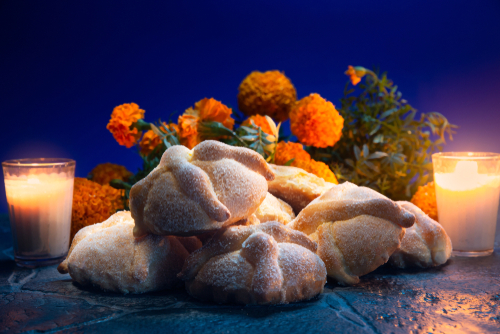
Celebrating Day of the Dead respectfully as non-Mexican Canadians
As with any cultural tradition, understanding and respect are key when celebrating Day of the Dead. A simple way to distinguish between honouring the tradition and being disrespectful is through two concepts: appreciation and appropriation.
- Appreciation means taking the time to understand the culture and participating sincerely.
- Appropriation refers to using cultural symbols inappropriately or for commercial gain, especially when there is no effort to understand the true meaning of Day of the Dead.
Consider supporting Mexican businesses, donating to Mexican-led non-profit organizations, and attending Mexican workshops and art exhibits throughout the year. Engaging beyond a single day will lead to a better understanding of the culture as a whole.
Embracing Day of the Dead in Canada
Celebrating Day of the Dead in Canada is more than a parade or a party. It’s a meaningful way of paying tribute and honouring loved ones while encouraging joy, remembrance, and community.
Learn about the culture by subscribing to newsletters from organisations involved in Day of the Dead locally. Attending workshops, performances, and exhibitions can provide a fuller experience.
If you want to learn more, take a look at:
- Casa Maiz in Toronto
- The Mexican Cultural Institute (part of the Consulate General of Mexico) in Montreal
- The Vancouver Latin American Cultural Centre
FAQs
What countries celebrate the Day of the Dead?
The tradition originates in Mexico, but many Central and South American countries, like Belize and Ecuador, also celebrate. You’ll also find Day of the Dead celebrations in Canada, the US, Italy, and beyond.
How is Day of the Dead celebrated in Canada?
In Canada, Day of the Dead celebrations are organised by Mexican-Canadian communities, and all are welcome. Typical events include family-friendly festivals, community altars, and workshops and performances centred around traditions, music, and art.
Is the Day of the Dead November 1 or 2?
Both. The Day of the Dead (Día de los Muertos) is a two-day religious holiday to honour deceased loved ones.
